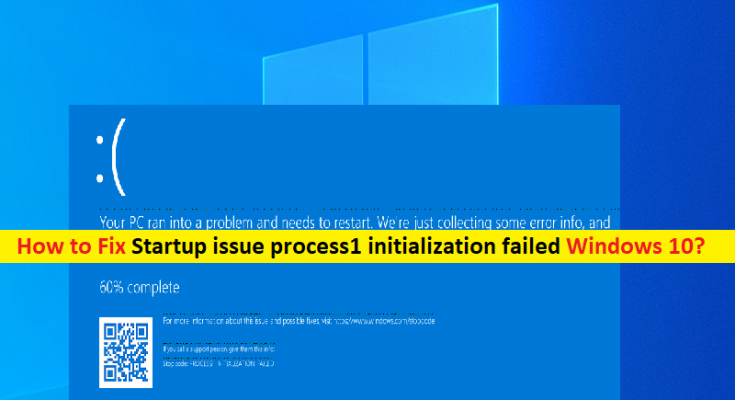What is ‘Startup issue process1 initialization failed’ – BSOD error in Windows 10?
In this article, we are going to discuss on How to fix Startup issue process1 initialization failed Windows 10. You will be guided with easy steps/methods to resolve the issue. Let’s starts the discussion.
‘Startup issue process1 initialization failed’ – BSOD error in Windows 10:
‘Startup issue process1 initialization failed’ error is common Windows Problem considered as Blue Screen of Death (BSOD) error. This BSOD error is appeared with message saying ‘Your PC ran into a problem and needs to restart. We’re just collecting some error info, and then we’ll restart for you’ along with some Windows Stop Codes like ‘Process1 Initialization Failed STOP 0x0000006B’ error.
This BSOD error is usually appeared in the middle of your work on computer or when you start/restart your Windows 10/11 computer. There could be several reasons behind the issue including outdated/corrupted Windows device drivers, outdated Windows OS, corruption in system files or registry, or in system image, malware or viruses infections in computer, and other windows issues.
You should make sure all device drivers are properly installed in your computer and are up-to-date to latest & compatible version, and also make sure Windows OS is up-to-date to latest version. Updating all device drivers and Windows OS in computer can resolve this type of issue. If the issue is still persist, you can follow our instructions to fix the issue. Let’s go for the solution.
How to fix Startup issue process1 initialization failed Windows 10?
Method 1: Fix ‘Startup issue process1 initialization failed’ – BSOD error with ‘PC Repair Tool’
‘PC Repair Tool’ is easy & quick way to find and fix BSOD errors, DLL errors, EXE errors, problems with programs/applications, malware or viruses issues, system files or registry issues, and other system issues with just few clicks.
Method 2: Update Device Drivers in Windows PC
Updating all necessary device drivers to latest & compatible version can resolve the issue. You can update all Windows drivers including graphics card drivers, sound card drivers and other device drivers using Automatic Driver Update Tool. You can get this tool through button/link below.
Method 3: Update Windows 10 OS
Updating Windows OS latest version can resolve the issue.
Step 1: Open ‘Settings’ app in Windows PC via Windows Search Box and go to ‘Update & Security > Windows Update’ and click ‘Check for updates’ button
Step 2: Download and install all available updates in your computer and once updated, restart your computer and check if the issue is resolved.
Method 4: Run Blue Screen troubleshooter

Windows built-in Blue Screen troubleshooter can resolve the issue. Let’s try.
Step 1: Open ‘Settings’ app in Windows PC and go to ‘Update & Security > Troubleshoot’
Step 2: Find and click ‘Blue Screen’ troubleshooter, and click ‘Run the troubleshooter’ button and follow on-screen instructions to finish troubleshooting. Once finished, check if the issue is resolved.
Method 5: Run SFC scan, DISM scan and CHKDSK scan

You can run SFC scan, DISM scan and CHKDSK scan in computer in order to fix corruption in system files and in system image, and hard disk drive corruption.
Step 1: Type ‘cmd’ in Windows Search Box and press ‘SHIFT + ENTER’ keys on keyboard to open ‘Command Prompt as Administrator’
Step 2: Type the following commands one-by-one and hit ‘Enter’ key after each line to execute.
sfc /scannow
DISM /Online /Cleanup-Image /RestoreHealth
chkdsk /f /r C:
Step 3: Once executed, restart your computer and check if the issue is resolved.
Method 6: Delete Bootcat.cache
Step 1: Restart your computer several time until you see Windows Recovery Environment screen
Step 2: Select ‘Troubleshoot > Advanced Options > Command Prompt’ and execute the following command
C:
cd windows/system32/codeintegrity
del bootcat.cache
Step 3: Once executed, restart your computer and check if the issue is resolved.
Method 7: Disable Secure Boot
Another possible way to fix the issue is to disable Secure Boot feature in your Windows computer. You can disable Secure Boot feature through BIOS settings of your computer, and once done, check if the issue is resolved.
Method 8: Check your hardware
This issue can be occurred due to some issue with hardware like hard disk, RAM, cables, and other memory. You can download & install MemTest86+ tool in your computer in order to thoroughly test your RAM and check and fix the issue.
Method 9: Perform System Restore
If the issue is still persist, you can perform System Restore in your computer in order to fix the issue.
Step 1: Press ‘Windows + R’ keys on keyboard, type ‘rstrui’ in ‘Run’ window and hit ‘Ok’ button to open ‘System Restore’
Step 2: Click ‘Next’, select valid restore point according to date & time when there was no issue at all in computer, and then click ‘Next > Finish’ to start restoring process and once done, check if the issue is resolved.
Conclusion
I am sure this post helped you on How to fix Startup issue process1 initialization failed Windows 10 with several easy steps/methods. You can read & follow our instructions to do so. That’s all. For any suggestions or queries, please write on comment box below.



